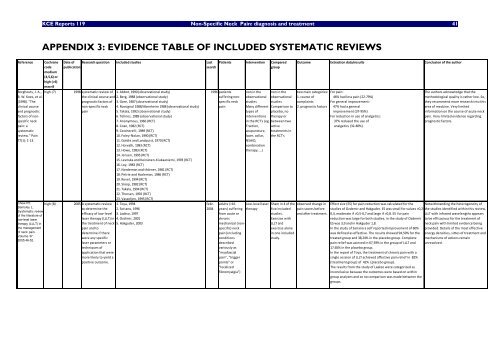Non-specific neck pain: diagnosis and treatment - KCE
Non-specific neck pain: diagnosis and treatment - KCE
Non-specific neck pain: diagnosis and treatment - KCE
You also want an ePaper? Increase the reach of your titles
YUMPU automatically turns print PDFs into web optimized ePapers that Google loves.
Reference Cochrane<br />
code<br />
medium<br />
(4,5,6) or<br />
high (>6)<br />
max=8<br />
Borghouts, J. A.,<br />
B. W. Koes, et al.<br />
(1998). "The<br />
clinical course<br />
<strong>and</strong> prognostic<br />
factors of non‐<br />
<strong>specific</strong> <strong>neck</strong><br />
<strong>pain</strong>: a<br />
systematic<br />
review." Pain<br />
77(1): 1‐13.<br />
<strong>KCE</strong> Reports 119 <strong>Non</strong>-Specific Neck Pain: <strong>diagnosis</strong> <strong>and</strong> <strong>treatment</strong> 41<br />
APPENDIX 3: EVIDENCE TABLE OF INCLUDED SYSTEMATIC REVIEWS<br />
Date of Research question Included studies Last<br />
publication<br />
search<br />
high (7) 1998 systematic review of 1. Abbot, 1990 (observational study)<br />
the clinical course <strong>and</strong> 2. Berg, 1988 (observational study)<br />
prognostic factors of 3. Gore, 1987 (observational study)<br />
non‐<strong>specific</strong> <strong>neck</strong> 4. Rossignol 1988/Abenheim 1988 (observational study)<br />
<strong>pain</strong><br />
5. Takala, 1992 (observational study)<br />
6. Tellnes, 1989 (observational study)<br />
7. Anonymous, 1966 (RCT)<br />
8. Coan, 1982 (RCT)<br />
9. Ceccherelli, 1989 (RCT)<br />
10. Foley‐Nolan, 1990 (RCT)<br />
11. Goldie <strong>and</strong> L<strong>and</strong>quist, 1970 (RCT)<br />
12. Horvath, 1983 (RCT)<br />
13. Howe, 1983 (RCT)<br />
14. Jensen, 1995 (RCT)<br />
15. Levoska <strong>and</strong> Keinänen‐Kiukaaniemi, 1993 (RCT)<br />
16. Loy, 1983 (RCT)<br />
17. Nordeman <strong>and</strong> thörner, 1981 (RCT)<br />
18. Petrie <strong>and</strong> Hazleman, 1986 (RCT)<br />
19. Revel, 1994 (RCT)<br />
20. Sloop, 1982 (RCT)<br />
21. Takala, 1994 (RCT)<br />
22. Thorsen, 1992 (RCT)<br />
23. Vasseljen, 1995 (RCT)<br />
Chow RT, high (8) 2005 A systematic review 1. Toya, 1994<br />
Barnsley L:<br />
Systematic review<br />
of the literature of<br />
low-level laser<br />
to determine the 2. Soriano, 1996<br />
efficacy of low‐level 3. Laakso, 1997<br />
laser therapy (LLLT) in 4. Ozdimir, 2001<br />
therapy (LLLT) in<br />
the <strong>treatment</strong> of <strong>neck</strong> 5. Hakguder, 2003<br />
the management<br />
<strong>pain</strong> <strong>and</strong> to<br />
of <strong>neck</strong> <strong>pain</strong>.<br />
Volume 37.<br />
2005:46-52.<br />
determine if there<br />
were any <strong>specific</strong><br />
laser parameters or<br />
techniques of<br />
application that were<br />
more likely to yield a<br />
positive outcome.<br />
febr.<br />
2004<br />
Patients Intervention Compared<br />
group<br />
1996 patients<br />
suffering non‐<br />
<strong>specific</strong> <strong>neck</strong><br />
<strong>pain</strong><br />
non in the<br />
observational<br />
studies<br />
Many different<br />
types of<br />
interventions<br />
in the RCT's (eg.<br />
Traction,<br />
acupuncture,<br />
laser, collar,<br />
NSAID,<br />
combination<br />
therapy, …)<br />
adults (>16 Low‐level laser<br />
years) suffering therapy<br />
from acute or<br />
chronic<br />
mechanical (non‐<br />
<strong>specific</strong>) <strong>neck</strong><br />
<strong>pain</strong> (including<br />
conditions<br />
described<br />
variously as<br />
"myofascial<br />
<strong>pain</strong>", "trigger<br />
points" or<br />
"localized<br />
fibromyalgia")<br />
non in the<br />
observational<br />
studies<br />
Comparison to<br />
placebo, no<br />
therapy or<br />
between two<br />
active<br />
<strong>treatment</strong>s in<br />
the RCT's<br />
Sham in 4 of the<br />
five included<br />
studies.<br />
Exercise with<br />
LLLT <strong>and</strong><br />
exercise alone<br />
in one included<br />
study.<br />
Outcome Extraction data/results Conclusion of the author<br />
two main categories:<br />
1. course of<br />
complaints<br />
2. prognostic factors<br />
observed change in<br />
<strong>pain</strong> scores before<br />
<strong>and</strong> after <strong>treatment</strong>.<br />
For <strong>pain</strong>:<br />
46% had less <strong>pain</strong> (22‐79%)<br />
For general improvement:<br />
47% had a general<br />
improvement (37‐95%)<br />
For reduction in use of analgetics:<br />
37% redused the use of<br />
analgetics (32‐80%)<br />
Effect size (ES) for <strong>pain</strong> reduction was calculated for the<br />
studies of Ozdemir <strong>and</strong> Hakguder. ES was small for values >0,2‐<br />
0,4, moderate if >0,5‐0,7 <strong>and</strong> large if >0,8. ES for <strong>pain</strong><br />
reduction was large for both studies, in the study of Ozdemir<br />
ES was 3,9 <strong>and</strong> in Hakguder 1,8.<br />
In the study of Sariano a self reported improvement of 60%<br />
was defined as effective. The results showed 94,59% for the<br />
treated group <strong>and</strong> 38,24% in the placebo group. Complete<br />
<strong>pain</strong> relief was acieved in 67,59% in the group of LLLT <strong>and</strong><br />
17,65% in the placebo group.<br />
In the report of Toya, the <strong>treatment</strong> of chronic <strong>pain</strong> with a<br />
single session of LLLT achieved affective <strong>pain</strong> relief in 82%<br />
(<strong>treatment</strong> group) of 42% (placebo group).<br />
The results from the study of Laakso were categorized as<br />
inconclusive because the outcomes were based on within<br />
group analyses <strong>and</strong> so no comparison was made between the<br />
groups.<br />
The authors acknowledge that the<br />
methodological quality is rather low. So,<br />
they recommend more research into this<br />
area of medcine. Very limited<br />
information on the course of acute <strong>neck</strong><br />
<strong>pain</strong>. Very limited evidence regarding<br />
prognostic factors.<br />
Notwithst<strong>and</strong>ing the heterogeneity of<br />
the studies identified within this review,<br />
LLLT with infrared wavelengths appears<br />
to be efficacious for the <strong>treatment</strong> of<br />
<strong>neck</strong> <strong>pain</strong> with limited evidence being<br />
provided. Details of the most effective<br />
energy densities, sittes of <strong>treatment</strong> <strong>and</strong><br />
mechanisms of actions remain<br />
unresolved.

















